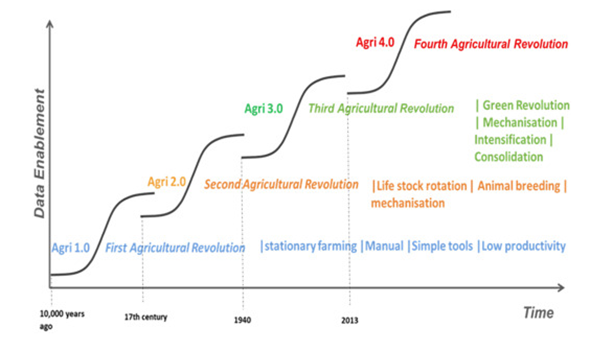In our fast-paced world, change is often hailed as the hallmark of progress. Agriculture and the business of family dynamics are no different. In almost all cases, change is brought about by the necessity to gain greater productivity, increased efficiencies and better use, or redistribution, of existing resources.
ScienceDirect has shown agriculture has undergone four major revolution periods or horizons, and each of these significant horizons have incremental advances to move from the early horizon introduction to exhaustion of the potential at the end of period.

As part of this process, farmers have embraced the transformations in the field. Therefore, this has also appeared in the workplace, in family and personal development, and in society as a whole. Yet, what often goes without acknowledgement is the value of what comes after change: the reset.
‘Resetting’ and ‘Consolidation’ are not ‘buzz words’ about slowing down progress.
They are about the value of change, grounding the adjustments and sustaining the influences. The process of reset and consolidation ensures the change leads to a meaningful and lasting impact. Ignoring this step risks not only fatigue and confusion, but also the loss of valuable momentum. In this article, we explore why a strategic reset is not a luxury but a necessity after any change.
Understanding Resetting and Consolidation
Resetting refers to intentionally pausing to reflect on recent changes, evaluate outcomes, and realign goals and processes with the change. Resetting gives us the time for mental and emotional clarity to manifest, to fully understand what has changed and the impacts.
Consolidation is about strengthening and stabilising those changes – integrating them into daily routines, systems, and mindsets so they become the new normal. Consolidation ensures we can operate effectively in this new place.
The Emotional Impact of Change
Change, even when positive, can be emotionally taxing. New (or reduced) responsibilities, unfamiliar environments, or altered expectations can lead to stress, uncertainty, and resistance. People can feel overwhelmed or disengaged, and this often shows up as confusion, reduced morale, or misaligned efforts.
Resetting allows individuals and therefore the business a moment to catch breath and reconnect with purpose.
Why Consolidation Matters
Too often, we leap from one change initiative to another without ensuring the last one takes root. This creates a culture of constant transition without stability. The result? Change fatigue, cynicism, and underperformance.

Consolidation helps in:
- Reinforcing learning: Lessons from recent change are more likely to be absorbed when people have time to reflect and apply them.
- Building confidence: Individuals feel more capable and empowered when new behaviours and processes become routine.
- Creating alignment: Teams can ensure their efforts are coordinated and aligned with overarching goals.
- Measuring progress: Consolidation allows time for data collection and result assessments, so leaders can make informed decisions about next steps.
Signs It’s Time for a Reset
How do you know when a reset is necessary? Here are some indicators:
- Confusion or miscommunication: People are unclear on new roles, expectations, or processes.
- Fatigue or burnout: There’s a noticeable drop in energy, enthusiasm, or productivity.
- Declining performance: Metrics are stagnating or slipping, and efforts to improve are not yielding results.
- Feedback loops are broken: Leaders aren’t getting honest input, or employees feel disconnected from decision-making.
- Change hasn’t “stuck”: Initiatives are being ignored or inconsistently implemented.
If these signs are present, it’s time to step back – not to stop progress, but to reinforce it.
How to Effectively Reset and Consolidate
1. Create Space for Reflection
Start by intentionally carving out time for individuals and teams to look back. Ask reflective questions:
- What have we learned?
- What has gone well?
- What needs adjustment?
- How are people feeling about the changes?

This can take the form of workshops, surveys, or one-on-one check-ins.
2. Revisit Purpose and Goals
Why. Clarify how the change aligns with long-term vision and values.
3. Streamline Processes
New procedures, tools, or structures. Use the reset period to simplify where possible. Eliminate redundancies and clarify workflows to operate effectively in the new system.
4. Rebuild Culture and Relationships
Use this period to nurture collaboration, rebuild trust, and reinforce core values. Celebrate wins, acknowledge challenges, and recognise individual contributions.
5. Ensure Capacity and Support
Provide resources and training to ensure workloads are realistic and that individuals have the tools they need to thrive.
6. Establish Feedback Loops
Create channels for ongoing input. This allows for real-time course correction and makes people feel heard and valued.
7. Set the Stage for Future Growth
A successful reset is a foundation for what comes next. Consolidate your learning and outline the path forward with clarity and intention.
The Business Case for Resetting
From a strategic standpoint, resetting and consolidating provide clear ROI. Organisations that do this well experience:
- Stronger employee engagement
- Higher adoption of new initiatives
- Improved performance metrics
- More sustainable growth
- Greater adaptability for future change
It’s not about taking your foot off the gas—it’s about checking your map, tuning your engine, and ensuring everyone is still on board.

The Personal Reset
These principles apply equally to individuals. After a significant life shift—a new job, a move, the end of a relationship—it’s important to pause, reflect, and rebuild. Ask yourself:
● Who am I now, after this change?
● What do I need to feel grounded?
● How do I want to move forward?Self-care, journaling, goal setting, and mindfulness are powerful tools for personal consolidation.
Final Thoughts
Pausing may feel counterintuitive in a world that glorifies hustle and perpetual motion. But actual progress doesn’t come from constant acceleration – it comes from intentional direction.
You could be charging up the wrong path.
Resetting and consolidating after change ensures that you’re not just moving but moving with purpose.
Whether you’re leading a team through transformation or navigating a personal crossroads, don’t underestimate the power of the pause. It’s where resilience is built, wisdom is gained, and the future is forged with clarity.


